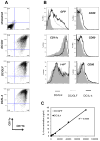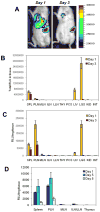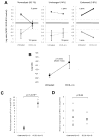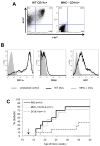Tissue-targeted therapy of autoimmune diabetes using dendritic cells transduced to express IL-4 in NOD mice
- PMID: 18337172
- PMCID: PMC2453076
- DOI: 10.1016/j.clim.2007.12.009
Tissue-targeted therapy of autoimmune diabetes using dendritic cells transduced to express IL-4 in NOD mice
Abstract
A deficit in IL-4 production has been previously reported in both diabetic human patients and non-obese diabetic (NOD) mice. In addition, re-introducing IL-4 into NOD mice systemically, or as a transgene, led to a beneficial outcome in most studies. Here, we show that prediabetic, 12-week old female NOD mice have a deficit in IL-4 expression in the pancreatic lymph nodes (PLN) compared to age-matched diabetes-resistant NOD.B10 mice. By bioluminescence imaging, we demonstrated that the PLN was preferentially targeted by bone marrow-derived dendritic cells (DCs) following intravenous (IV) administration. Following IV injection of DCs transduced to express IL-4 (DC/IL-4) into 12-week old NOD mice, it was possible to significantly delay or prevent the onset of hyperglycemia. We then focused on the PLN to monitor, by microarray analysis, changes in gene expression induced by DC/IL-4 and observed a rapid normalization of the expression of many genes, that were otherwise under-expressed compared to NOD.B10 PLN. The protective effect of DC/IL-4 required both MHC and IL-4 expression by the DCs. Thus, adoptive cellular therapy, using DCs modified to express IL-4, offers an effective, tissue-targeted cellular therapy to prevent diabetes in NOD mice at an advanced stage of pre-diabetes, and may offer a safe approach to consider for treatment of high risk human pre-diabetic patients.
Figures






Similar articles
-
Dendritic cells transduced to express interleukin 4 reduce diabetes onset in both normoglycemic and prediabetic nonobese diabetic mice.PLoS One. 2010 Jul 29;5(7):e11848. doi: 10.1371/journal.pone.0011848. PLoS One. 2010. PMID: 20686610 Free PMC article.
-
Prevention of diabetes in nonobese diabetic mice by dendritic cell transfer.J Clin Invest. 1992 Sep;90(3):741-8. doi: 10.1172/JCI115946. J Clin Invest. 1992. PMID: 1522229 Free PMC article.
-
Passive transfer of flt-3L-derived dendritic cells delays diabetes development in NOD mice and associates with early production of interleukin (IL)-4 and IL-10 in the spleen of recipient mice.Clin Exp Immunol. 2003 Dec;134(3):388-95. doi: 10.1111/j.1365-2249.2003.02308.x. Clin Exp Immunol. 2003. PMID: 14632742 Free PMC article.
-
Regulatory Th2 response induced following adoptive transfer of dendritic cells in prediabetic NOD mice.Eur J Immunol. 2002 Jul;32(7):2021-30. doi: 10.1002/1521-4141(200207)32:7<2021::AID-IMMU2021>3.0.CO;2-J. Eur J Immunol. 2002. PMID: 12115623
-
Type I diabetes mellitus: a predictable autoimmune disease with interindividual variation in the rate of beta cell destruction.Clin Immunol Immunopathol. 1989 Jan;50(1 Pt 2):S85-95. doi: 10.1016/0090-1229(89)90115-3. Clin Immunol Immunopathol. 1989. PMID: 2642771 Review.
Cited by
-
Dendritic cells transduced to express interleukin 4 reduce diabetes onset in both normoglycemic and prediabetic nonobese diabetic mice.PLoS One. 2010 Jul 29;5(7):e11848. doi: 10.1371/journal.pone.0011848. PLoS One. 2010. PMID: 20686610 Free PMC article.
-
Antigen-specific therapeutic approaches in Type 1 diabetes.Cold Spring Harb Perspect Med. 2012 Feb;2(2):a007773. doi: 10.1101/cshperspect.a007773. Cold Spring Harb Perspect Med. 2012. PMID: 22355799 Free PMC article. Review.
-
Enhancement of CTLs induced by DCs loaded with ubiquitinated hepatitis B virus core antigen.World J Gastroenterol. 2012 Mar 28;18(12):1319-27. doi: 10.3748/wjg.v18.i12.1319. World J Gastroenterol. 2012. PMID: 22493545 Free PMC article.
-
The Role of Cell Organelles in Rheumatoid Arthritis with Focus on Exosomes.Biol Proced Online. 2021 Nov 4;23(1):20. doi: 10.1186/s12575-021-00158-4. Biol Proced Online. 2021. PMID: 34736402 Free PMC article. Review.
-
High-Yield Generation of Glucose-Responsive Pseudoislets From Murine Insulinoma Cells for In Vitro Studies and Longitudinal Monitoring of Graft Survival In Vivo.Cell Transplant. 2025 Jan-Dec;34:9636897251315123. doi: 10.1177/09636897251315123. Cell Transplant. 2025. PMID: 39881520 Free PMC article.
References
-
- Shoda L, Young D, Ramanujan S, Whiting C, Atkinson M, Bluestone J, Eisenbarth G, Mathis D, Rossini A, Campbell S, Kahn R, Kreuwel H. A comprehensive review of interventions in the NOD mouse and implications for translation. Immunity. 2005;23:115–26. - PubMed
-
- Roep B, Atkinson M, von Herrath M. Satisfaction (not) guaranteed: re-evaluating the use of animal models of type 1 diabetes. Nat Rev Immunol. 2004;4:989–97. - PubMed
-
- Creusot R, Fathman CG, Muller-Ladner U, Tarner I. Targeted gene therapy of autoimmune diseases: advances and prospects. Expert Rev Clin Immunol. 2005;1:385–404. - PubMed
-
- Cameron M, Arreaza G, Zucker P, Chensue S, Strieter R, Chakrabarti S, Delovitch T. IL-4 prevents insulitis and insulin-dependent diabetes mellitus in nonobese diabetic mice by potentiation of regulatory T helper-2 cell function. J Immunol. 1997;159:4686–92. - PubMed
Publication types
MeSH terms
Substances
Grants and funding
LinkOut - more resources
Full Text Sources
Other Literature Sources
Medical
Molecular Biology Databases
Research Materials

